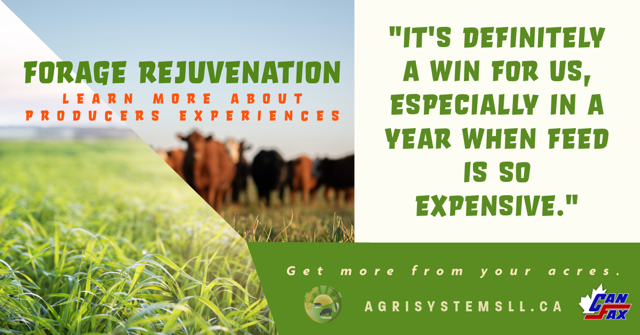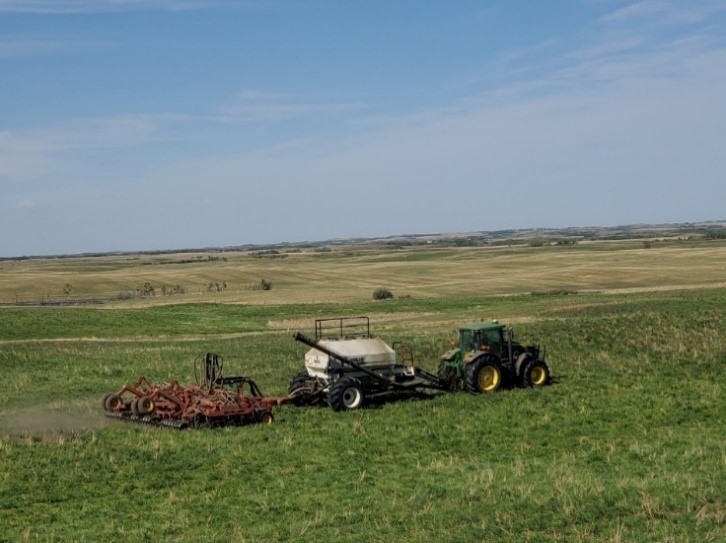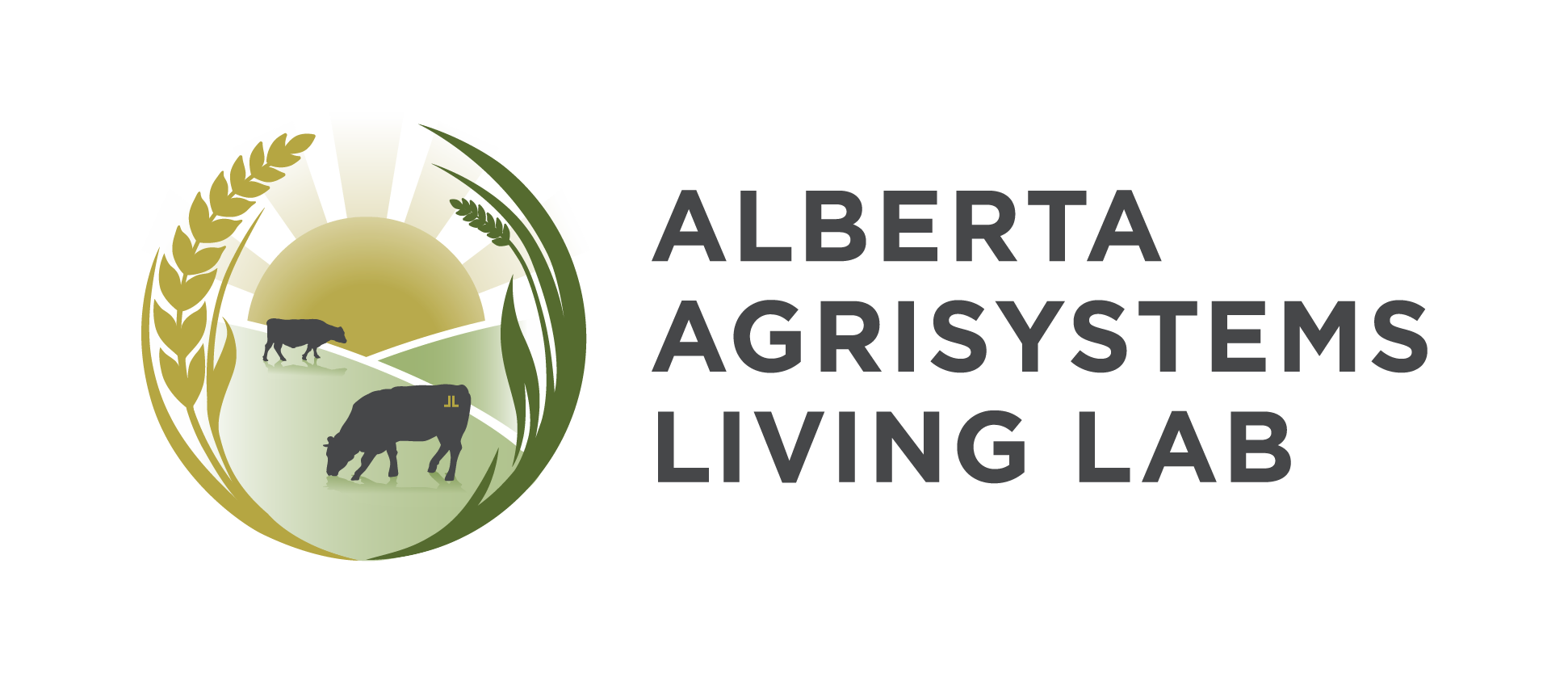L'utilisation de fourrages annuels et vivaces pour améliorer la productivité
Cet article fait partie d’une série d’études de cas sur les pratiques de gestion bénéfique des fourrages de l’Alberta Agrisystems Living Lab et de Canfax. Il est reproduit sur le site BeefResearch.ca avec la permission de l’auteur.

Que puis-je faire pour améliorer la productivité des pâturages ou augmenter mon approvisionnement en aliments pour animaux ? Plusieurs pratiques de gestion bénéfiques (PGB) peuvent améliorer le rendement des pâturages ou des aliments pour animaux, augmenter la proportion d’espèces souhaitables dans un peuplement fourrager, améliorer la qualité globale du fourrage ou avoir des effets bénéfiques sur la qualité du sol. Diverses méthodes peuvent être utilisées pour atteindre ces objectifs, telles que la gestion des pâturages, le réensemencement, le sursemis, l’utilisation de différents mélanges de fourrage (pour les pâturages ou la production d’aliments pour animaux), l’application d’engrais/de fumier et/ou l’application d’herbicides. Les avantages de ces pratiques peuvent être l’augmentation des rendements, l’amélioration du gain journalier moyen, l’augmentation du potentiel de rétention de l’humidité du sol, l’augmentation du nombre de jours de pâturage, la réduction des coûts d’alimentation en hiver ou de l’impact de la sécheresse, et l’amélioration de l’état corporel des vaches.1
Trois producteurs ont fait part de leurs expériences directes avec les PGB suivantes, afin que leurs idées et leurs connaissances puissent aider d’autres personnes désireuses d’essayer ces pratiques dans leur propre exploitation :
- Cultures intercalaires de blé et d’ivraie italienne
- Rajeunissement des pâturages cultivés
- Mélanges fourragers pour l’ensilage
- Maintien d’une composition optimale des espèces avec le pâturage intensif
Points essentiels à prendre en compte pour améliorer la disponibilité des aliments pour animaux
- Choisissez les bonnes espèces et variétés pour votre région : La quantité d’humidité au moment de l’ensemencement est essentielle à la réussite, il faut donc choisir des plantes adaptées à votre région et aux niveaux de précipitations et d’humidité du sol. L’outil « Forage U-Pick » du Beef Cattle Research Council peut vous aider à choisir les espèces en fonction des caractéristiques de votre champ.
- Utiliser le pâturage comme un outil : S’il est vrai que le report du pâturage est une étape importante pour permettre aux semis de s’établir, dans certains cas, l’augmentation de la pression de pâturage peut ouvrir un espace pour les nouveaux semis tout en conservant une partie de l’ancien peuplement. Cela peut permettre d’éviter une année de pâturage perdue.
- Réduisez les coûts là où vous le pouvez : Dans chacun de ces cas, les machines utilisées pour l’ensemencement et la fertilisation appartenaient déjà à l’exploitation. Si un ensemencement ou une fertilisation sur mesure est nécessaire, les coûts peuvent augmenter considérablement et vous devrez peut-être faire preuve d’une plus grande créativité.
Cultures intercalaires de blé et d’ivraie italienne
Susan Heather a lancé un projet de cultures intercalaires sur sa ferme près de Nanton, en Alberta, en 2023. L’objectif de ce projet de laboratoire vivant d’Alberta AgriSystems était de réduire l’érosion éolienne, d’augmenter le nombre de jours de pâturage et de capter davantage d’humidité pendant les trois mois où le champ reste normalement nu. Le champ se trouve sur un site de gravier récupéré, et Susan voulait faire « juste ces petites choses pour essayer de le rendre un peu plus productif » et ajouter plus de matière organique.
Le blé a été semé à l’aide d’un semoir à air et l’ivraie italienne a été épandue sur le champ le lendemain de l’ensemencement du blé. Le champ a ensuite été roulé pour empêcher la perte d’humidité et augmenter le contact entre les semences et le sol. La culture intercalaire a été plantée dans un champ irrigué. Le blé a été ensilé pour l’alimentation de l’exploitation de finition. Les vaches et les génisses pleines ont brouté l’ivraie à l’automne. Susan estime que la culture intercalaire a permis à l’ivraie de prendre un bon départ et d’être prête pour le pâturage peu de temps après l’enlèvement du blé. Le fumier et l’urine provenant du pâturage ont restitué des éléments nutritifs au sol et peuvent réduire la quantité d’engrais nécessaire à l’avenir.
« C’est une victoire pour nous, surtout dans une année où les aliments pour animaux sont si chers. » – Susan Heather, productrice de bœuf de l’Alberta
Les Heather pensaient que le rendement de la culture de blé souffrirait de la concurrence avec l’ivraie, mais, à leur grande surprise, ils ont « constaté une augmentation du tonnage de notre ivraie italienne avec le blé par rapport à quand il n’y avait que du blé ». L’ajout de ce champ à la rotation des pâturages a permis de réduire la pression exercée par le pâturage sur les prairies indigènes. Un mois de décembre chaud en 2023 a permis de poursuivre le pâturage pendant une bonne partie du mois de janvier, ce qui a considérablement réduit la durée et le coût de l’alimentation hivernale.
L’irrigation a été un facteur clé de la réussite de ce projet ; cependant, d’autres producteurs locaux de terres arides ont eu du succès avec des systèmes de cultures intercalaires similaires. Il est important de tenir compte de la quantité de précipitations et de l’humidité du sol si vous envisagez de pratiquer la culture intercalaire, et il peut être utile de consulter votre agronome local ou votre représentant en semences. Il s’agit d’une bonne pratique de gestion qui peut être utile aux producteurs désireux d’augmenter le nombre de jours de pâturage dans leurs champs de culture, tout en réduisant l’utilisation d’engrais.
Principal conseil
Ayez un objectif clair en tête : Cela permet de décider des outils à utiliser et de savoir si vous utilisez la bonne approche pour atteindre cet objectif. Quelles sont les améliorations spécifiques que vous souhaitez obtenir ?
Rajeunissement des pâturages cultivés

En 2020, Terri et Brad Mappin voulaient améliorer une parcelle de pâturage récemment achetée et qui n’avait pas été entretenue sur leur ferme près de Byemoor, en Alberta. Décrit par Terri comme « un méli-mélo dont on ne sait pas trop ce que c’était », Brad a utilisé un semoir à air après quelques passages de disques pour obtenir un mélange de graminées et de légumineuses plus homogène. Malheureusement, Brad a semé trop profondément la première fois et n’a pas obtenu beaucoup de croissance. Après quelques saisons d’essais et d’erreurs, et quelques pluies opportunes, ils ont obtenu le mélange de graminées et de légumineuses plus épais et plus sain qu’ils espéraient.
Un deuxième pâturage de l’exploitation des Mappin, dégradé après quelques saisons comme pâturage de vêlage. Ils ont fait pâturer massivement jusqu’à la mi-juin, défriché, ensemencé et fertilisé. Le pâturage intensif a permis de réduire la concurrence pour les nouveaux semis tout en gardant un peu de pâturage disponible pour un autre pâturage rapide plus tard dans l’été. La rapidité de ce dernier passage a été déterminante, comme le précise Terri : « J’ai fait passer les vaches assez rapidement (1 à 2 jours maximum) pour qu’elles ne touchent pas les jeunes pousses. » La crainte était que si les vaches dépassaient la litière précédente et atteignaient les semis, elles surpâtureraient les nouvelles pousses tendres et mettraient en péril les plantes nouvellement établies.
Les Mappin ont constaté une augmentation du poids des veaux en raison de la meilleure nutrition apportée par les nouveaux peuplements, mais il était difficile de comparer la production de fourrage avant et après le rajeunissement en raison de la sécheresse de 2021. Cependant, ils ont pu conserver une bonne réserve de foin et le pâturage rajeuni a encore été pâturé l’année suivante malgré les conditions de sécheresse.
Principaux conseils
- S’adapter : L’ensemencement dépend fortement de l’humidité, il est donc essentiel d’avoir des plans d’ensemencement et de pâturage prêts en cas de conditions défavorables.
- Ne vous attendez pas à des résultats parfaits dès le début : Si vous le pouvez, prévoyez des aliments supplémentaires au cas où la nouvelle culture ne s’établirait pas bien, et soyez prêt à faire des essais et des erreurs jusqu’à ce que vous trouviez ce qui fonctionne le mieux pour vous.
- Commencer petit : commencer par un projet de rajeunissement partiel permet de répartir les risques liés à la sécheresse, à une mauvaise implantation ou à une croissance lente du fourrage.
Mélanges fourragers pour l’ensilage
Derek Friend a opté pour un mélange de 12 espèces de fourrage pour la production d’ensilage en 2023 pour son exploitation vache-veau dans le centre de l’Alberta. Auparavant, il avait planté une monoculture en rotation d’orge, d’avoine, de blé, de pois ou de canola dans son champ. L’objectif pour ce champ était de trouver un mélange d’ensilage qui pourrait équilibrer des intrants plus faibles, rajeunir le sol et maintenir des rendements acceptables. Ce nouveau mélange comprend de l’ivraie italienne, du radis, du trèfle, du millet, du colza fourrager, de l’avoine, d’autres graminées et de l’orge comme base. Derek a limité le travail du sol à un seul passage de disque au lieu des 3 ou 4 passages habituels et a semé en mai pour s’assurer que les espèces de saison chaude ne seraient pas touchées par une gelée tardive. Il n’a pas non plus ajouté d’engrais, si bien que le nombre total de passages sur le champ a été bien inférieur à celui des années précédentes.
Derek pensait que le rendement de l’ensilage serait moindre en raison du travail minimal du sol et de l’absence d’engrais, mais, avec environ « plus de 10 tonnes par acre », le résultat était probablement plus proche d’un rendement moyen que de la récolte la plus faible à laquelle il s’attendait. En fin de compte, il s’agit d’un excellent résultat qui permet de maintenir les coûts de carburant et d’équipement à un niveau peu élevé. Bien que ce mélange ait fonctionné dans l’exploitation de Derek, il est important de garder des attentes réalistes et de sélectionner les espèces en fonction de leur capacité à pousser ensemble pour passer à ces mélanges.
Maintien d’une composition optimale des espèces avec le pâturage intensif
Une stratégie utilisée par Derek pour tirer le meilleur parti de son pâturage et éviter qu’une espèce ne devienne dominante est une rotation intense, presque quotidienne, du pâturage. Le passage d’un système de pâturage estival continu à un pâturage intensif en rotation a été effectué pour que toutes les espèces du pâturage soient uniformément pâturées. Comme les Mappin, il est difficile de comparer la condition corporelle et le gain moyen quotidien d’une année sur l’autre dans les années 2020, mais Derek a remarqué que ses vaches mangeaient davantage en raison de la compétition pour les meilleures bouchées.
Principaux conseils
- Réduire l’intensité du travail du sol peut être une mesure de réduction des coûts : bien que le plein labour puisse produire un rendement plus élevé, il ajoute également des coûts et peut être plus risqué si les précipitations n’arrivent pas à temps et en quantité nécessaire.
- Utiliser les bovins pour maintenir un bon mélange d’espèces : Un pâturage lourd et ciblé peut empêcher les espèces moins appétissantes de devenir dominantes et le fait d’accorder des périodes de repos plus longues aux parcelles permet aux espèces plus appétissantes de repousser davantage avant le nouveau pâturage.
1Omokanye, A., Yoder, C., Sreekumar, L., Vihvelin, L., & Benoit, M. (2018). Forage production and economic performance of pasture rejuvenation methods in northern Alberta, Canada. Sustainable Agriculture Research, 7(2), 94-110.
Le partage ou la réimpression des articles du www.BeefResearch.ca est généralement bienvenu et encouragé, mais cet article nécessite l’autorisation de l’éditeur d’origine.
Vos questions, commentaires et suggestions sont les bienvenus. Contactez-nous directement ou suscitez un dialogue public en publiant vos réflexions ci-dessous.

